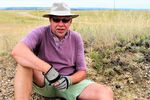From my Rockpile - Tulip City Gem & Mineral ...
←
→
Page content transcription
If your browser does not render page correctly, please read the page content below
August 2020 Volume 53, Edition 8 From my Rockpile As we are looking at the closing of summer due to back to school, there are many things that the Board members and I would like to share. Even though kids are heading back into the classroom (virtually or in-person), there are many locations you can still get out to collect. Rocks don’t even need to be the focus of collecting. I often get out for a sunset, a walk in the woods, or gazing at the stars in a dark place. As I am heading back into my (virtual) classroom for the school- year, I will still get in my trips to get Petoskey stones or a trip to Rockport to collect micro-fossils. I hope you and your family and friends can get outside too ! Thank you for all those that came out to our outdoors June General Meeting and those attending the picnic in July. It is very disappointing that the club is unable to hold their Annual Show. Despite valent efforts by your board members, it has been impossible to secure a location for our monthly General Meetings. I appreciate you being flexible with us during the pandemic. Often we are required to look at our routine club activities with a different perspective in order to maintain our #1 priority, our member’s health and safety. It is therefore the case that between the difficulty of a meeting space and the additional stress families will encounter with the starting of school, we have cancelled our August General Meeting and all September activities. On a positive note, the Board felt that since numerous opportunities to share our common hobby has been squashed by the pandemic, we are passing along an automatic extension of their TCGMC membership for 2020-2021. We value you as part of our membership and as a part of the TCGMC family, this is our gift to you. Stay healthy, be safe, and register to vote ! ! ! M.B. Larson
COVID-19: Staying active while you're staying home
While gyms, athletic events, and recreation centers around the country are shut-
tered due to COVID-19, it’s still important for everyone, young and old, to main-
tain regular exercise even while you’re staying home. Regular exercise is essen-
tial for well-being and leads to better immune function, decreased stress and
anxiety, and better sleep.
2020 TCG&M Board
Adults should try to spend 150-300 minutes per week – or 30 minutes per day –
President - Michael B. Larson
mblarson300@yahoo.com
doing moderate-intensity aerobic physical activity, and 2 sessions per week of
strength training. Try to fit in 2, 5, 10, or 20 minutes of physical activity, however
Vice President - Shari Luttikhuizen and wherever you can. Every active minute counts.
sluttikh@oaisd.org
Here are some ways you can stay active while you’re staying home.
Secretary - Brenda Olson
brendaolson01@gmail.com Activities to get your heart pumping
Treasurer - Kurt Brinks Indoor activities
kbrinks@hollandpublicschools.org Put some music on and walk briskly around the house or up and down the
Field Trip Coordinator - Jon Mull stairs for 10-15 minutes 2 or 3 times per day.
solace247@yahoo.com Dance to your favorite music.
Field Trip Coordinator - Bob Sinke Jump rope (if your joints can handle it).
bobsinke@comcast.net
Do an exercise video.
Historian - Betty Hoekstra
kbhoek@att.net Use home cardio machines if you have them.
Jr. Club Coord. - Rick Smith
Outdoor activities
Hollandrsmith@gmail.com Walk or jog around your neighborhood but avoid crowded spaces.
Jr. Club Coord. - Linda Winkelmann Be active in a local park. Spending time in nature may enhance immune
lindawinkelmann@att.net function. Be sure to maintain social distancing and wash your hands when
Liaison - Rhonda Gehringer
you get home.
rgehringer@homeoftheshamrocks.org Go for a bicycle ride.
Membership - Christine Silich Do gardening and yard work.
CSDS77@icloud.com
Play active games with your family.
Newsletter Ed. - < open >
Strength training
Download a strength workout app to your smart phone, one suggestion is
Social Media Coord. - Julia Sherwood
bobandjulia@accn.org the 7-Minute Workout (no equipment necessary).
Do a strength training video.
Show Coord. - Sue Goedert
sonbeams2000@yahoo.com Perform yoga – deep breathing and mindfulness can also reduce anxiety.
Social Coord. - Linda Plumert Find ways to do simple muscle-strengthening exercises around your house
rlplumert@gmail.com such as:
Dir. at Large - Mary Johnson Squats or sit-to-stands from a sturdy chair
maryjohnson299@gmail.com Push-ups against a wall, the kitchen counter, or the floor
Dir. at Large - Randy Wake Lunges or single-leg step-ups on stairs
rgwake@charter.net
Don’t sit all day!
Past President - C.H. Falstad
cfalstad@ameritech.net If you’re watching TV, get up during every commercial (or periodically) and do a
lap around your place or an active chore. For example, throw some clothes in
the laundry, do the dishes, or take out the garbage. You’ll feel productive after
just one show!Hello fellow rock collectors!
I don’t know about you, but I’ve been really missing our TCGMC field trips! Since buying a popup
camper, my husband and I have gone on a few mini field trips this summer. Our maiden voyage
took us to Wisconsin where we collected some nice material which we believe to be blue
jasper! We also went to Petoskey State Park where we managed to find quite a bit of Petoskey
stones a few agates and Charlevoix stones.
I really love finding out new places to collect, and I have found a few wonderful YouTube
channels. One of my favorites is “Michigan Rocks.” Rob is located in Alpena and he has a large
collection of videos on topics such as tumbling, lapidary and many videos of him collecting
material in various places throughout the state of Michigan.
Michigan Rocks: https://www.youtube.com/user/jugglerguy1
Another YouTube channel I enjoy is Agate dad. He is located in Minnesota and collects primarily
Agates.
Agate Dad: https://www.youtube.com/channel/UCkXGbf13yNPDgZStw4ReBaw
The Crystal Collector is the first YouTube channel I started following about rock collecting. There
are many, many videos of places open to the public to collect and he has most of his videos
organized into categories.
The Crystal Collector: https://www.youtube.com/user/surfer1582
Rookie Rockhounding is a channel based out of Australia. I love watching the beautiful opals and
chalcedony that he finds along the way! He even cuts many of his finds!
Rookie Rockhounding: https://www.youtube.com/user/CrazyCrazySillyFresh
There are many rockhounds out there, and many more wonderful YouTube channels devoted to
the hobby, and I’m sure you will find your favorite and perhaps someday be inspired to create
your own channel!
Enjoy,
Rhonda Gehringer (TCGMC Liaison)
On the Calendar:
8/26/20 TCG&MC General Meeting Cancelled
9/16/20 TCG&MC Board Meeting Virtual / ZOOM
9/18-20/20 2020 Tulip City Annual Show Cancelled
9/26/20 2020 Tulip City Club Tailgate Cancelled
9/30/20 TCG&MC General Meeting Virtual / ZOOM
10/14/20 TCG&MC Board Meeting Virtual / ZOOMYooperlites’ Appeal (Part 1)
https://www.rockngem.com/yooperlites-appeal-part-1/
Editor's Note: This is the first in a two-part series by Wayne Peterson about Yooperlites.
Yooperlites’ Appeal (Part 1)
Fluorescent Sodalite
April 9, 2019
It’s been nearly two years since Erik Rintamaki of Michigan’s Upper
Peninsula spotted something unfamiliar and utterly intriguing along
the shores of Lake Superior under the setting sun and evening sky.
The discovery of fluorescent sodalite, which Erik named
“Yooperlites,” caught the attention of geologists, mineralogists,
rockhounds, educators, and just about anyone who had lived in or This trio of Yooperlite specimens are part of the
visited the Upper Peninsula at one time or another. eye-catching display Erik presents at shows.
(Photo courtesy Wayne Peterson)
Naming Honors U.P. Citizenry
The origin of the name “Yooperlites” is the abated abbreviation of “U.P.” for
Michigan’s Upper Peninsula. “Yoopers” are the area’s colloquial citizenry. “Lite”
refers to the rock’s fluorescent properties from sodalite.
Since making the discovery, Erik has spent quite a bit of time talking about
Yooperlites and leading rockhounding tours. Of course, as a dedicated
rockhound whose hobby is also his business (www.yooperlites.com), a good
day rockhounding is a good day all around.
My wife, Brenda, and I had the good fortune of hearing Erik speak about his
discovery and spending time with him in September of 2018. Early in our
Erik Rintamaki, discoverer of
autumn travels, we went to the Upper Peninsula of Michigan, one of our
Yooperlites, holds a sphere favorite rockhounding areas. A few years earlier, we successfully explored
made of high quality sodalite. the western region of the U.P., so this time around we mapped out the
(Photo by Wayne Peterson)
eastern region to explore with hopes of finding prized Lake Superior agates.
The region is rich in mineral heritage and was the United States’ major supplier of copper for more than a
century. From the mid-1840s to 1968, the Keweenaw Peninsula mines produced an estimated 10.5 billion
pounds of copper.Combing Lake Superior Shores
Our second day into the trip, we stayed at Muskallonge Lake State Park, located on the U.P.’s northeast
shores near Newberry, Michigan. Upon arriving, the park ranger let us know that the annual Rock On with
Lake Superior Agates rock show had just started. What a great surprise! We did not waste any time. We set
up our campsite and went to the show.
The two-day event was packed with educational
demonstrations, rock and mineral presentations, and of
course tables of Lake Superior agates and other local
mineral specimens. There was something for all ages.
One of the presentations that especially caught my attention
was Erik’s Yooperlite display. During our time at the show,
Erik began sharing the story of the discovery made on the
shores of Lake Superior. We listened intently and examined
the amazing fluorescing display. We were so intrigued with
The well kept park entrance that greets visitors, including
the display that, as the show was closing for the first day, rockhounds set to search the shores of Lake Superior for
we decided then and there to change our travel plans and Yooperlites. (Photo by Wayne Peterson)
stay on for a few more days.
The next morning, I headed directly to the area where Erik was presenting. We talked for a few hours, and he
explained more about his discovery. He has been a rock collecting enthusiast since childhood. It began with
his dad taking him rock collecting when he was very young. Needless to say, he never lost the passion for
collecting or his curiosity about minerals.
Yooperlite Discovery Creates Opportunity
As we all know, necessity has been called the mother of innovation, and in Erik’s case it may be the mother
of discovery, too. In addition to being a collector and dealer of Lake Superior agates for years, he also
teaches others how to find the elusive U.P. treasures. In his quest to become more successful with his
knowledge of agates, his curiosity caused him to see if agates would fluoresce. One such night in June of
2017, with an inexpensive 3 LED UV long wave flashlight, he went rock hunting around 4 a.m. and
discovered a rock that looked like a hot lava ball. He was “excited beyond containment and wondered what
it was,” Erik explained.
Upon discovering two small specimens, he was hooked. Erik upgraded his equipment to include a 100 LED
UV flashlight, which significantly increased his discoveries. This led him to begin working with a
manufacturing company to produce a cost-efficient UV flashlight to help people locate Yooperlites.
As Erik would learn, his discovery of fluorescent sodalite would bring forth great interest from a variety of
people.
One example of this came about in January of 2018, when the online sale of some of Erik’s Yooperlites
attracted the attention of geologist Raymond Laughlin and Shawn M. Carlson, a geologist and mineralogist,
respectively, both from Michigan. They purchased some of Erik’s rocks and began to technically analyze the
specimens. With access to the geological laboratory at the Michigan Technological University (MTU) in
Houghton, Michigan, the technical assessment of the Yooperlite mineral was under way. I was intrigued to
learn of the connection to MTU, because during our first trip to the Upper Peninsula, we stopped at the A. E.
Seaman Mineral Museum, which is located on the campus grounds at MTU. It is one of the premier
collegiate mineral museums in the United States and very much worth visiting.The Mineralogy of Yooperlite
The following is an excerpt of the Yooperlite mineral analysis from MTU, (used with permission from Tony
Nikischer, publisher of Mineral News, info@excaliburmineral.com).
Preliminary SEM/EDS analyses conducted at Michigan Technological University showed only Na, Al, Si, Cl,
and O in the mineral’s spectrum. Sulfur was sought but not noted with EDS (below detection limits) but was
detected by follow-up EMP/WDS, which yielded a composition of: 36.47 wt.% SiO2, 30.84 wt.% Al2O3, 25.39
wt.% Na2O, 0.31 wt.% FeO, 0.05 wt.% K2O, 7.02 wt.% Cl, and 0.11 wt.% SO3 (average of three very similar
analyses). Microscopic studies were conducted using Kyowa SDZ-P binocular stereozoom microscope and a
Kyowa ME-POL2 petrographic and ore microscope equipped with a Supper spindle stage.
EDS spectra were obtained at Michigan Technological University on a JEOL 6400 tungsten-source SEM
equipped with a 4pi Analysis (Inc.) ultrathin window EDS detector and operated at 20 kV, using standards
from Astimex Standards (Ltd).
Yooperlite, which this analysis has shown, is a syenite clast containing fluorescent sodalite, at this point is
reportedly specific to the shores of Lake Superior in Chippewa and Luce Counties and in the Keweenaw
Peninsula. It is the first verified and documented sodalite from the state of Michigan. Geologically, it is thought
to have formed in Canada before being carried by glacier from the Canadian Shield (Laurentian Plateau) to
Michigan, according to the report.
After reading the technical analysis, it may seem like nothing was new in the mineralogical world since
sodalite is a fairly common mineral found in several places around the world. What makes this unique is that it
is the first time sodalite was discovered in Michigan. From an earth science and rock collecting perspective, it
is a great discovery. It is the type of discovery that creates a rudimentary basis for sparking interest in earth
sciences for young and old alike.
One never truly knows the influence an interest in earth
science may have. Case in point: It’s been said that a 5-
year-old Albert Einstein was given a compass by his
father, which sparked in Einstein a lifelong interest in the
nature of the magnetic field.
Enjoy a short video filmed by Erik as he
This display of Yooperlites is a popular attraction at hunted for Yooperlites along the shores of
Erik's table when he sets up at rock and mineral
shows. (Photo by Wayne Peterson) Lake Superior in December:
https://youtu.be/gYE3F6Umx9wGeneral Geology of Michigan
Michigan is unique among the states in that it is divided into two areas geographically, the Northern
and Southern Peninsulas, and in that, to a considerable degree, these two geographical provinces are
geologically separate and distinct. This geological dichotomy is not absolute, inasmuch as the
eastern part of the Northern Peninsula is geologically similar to parts of the Southern Peninsula.
The western part of the Northern Peninsula is underlain by rocks of Precambrian and Cambrian age.
In contrast, underlying rocks of the eastern Northern Peninsula and the entire Southern Peninsula
are younger (Ordovician to Pennsylvanian) in age.
In addition to this broad split, Michigan geology also is characterized by a major horizontal break-
bedrock geology vs. surficial geology. Much of the state is veneered by deposits of Pleistocene age,
the results of glacial and glaciofluvial depositional processes. These sediments are unconsolidated
tills, gravels, sands, silts, and clays. They effectively mask much of the bedrock geology, particularly
in the Southern Peninsula.
With a few exceptions, the spectacular metallic mineral deposits for which Michigan is justly famous
occur in rocks of Precambrian age. The younger Paleozoic rocks are by no means devoid of mineral
deposits or occurrences, but their variety is smaller and their mineral assemblages are more severely
restricted. Only a very few inconsequential mineral occurrences appear in the Pleistocene blanket.
Precambrian Geologic History
The Precambrian involves 85 to 90% of all geologic time. The oldest radiogenic date presently
recorded for Precambrian rocks is ca 3900 million years, and it is estimated that the earth
originated 4000 to 5000 million years ago. The Precambrian thus begins at some yet undetermined
time between 4500 and 3800 million years ago and extends to 500 million years ago-the age of the
oldest Paleozoic (Cambrian) sediments.
For this enormous span of time the rock record is incomplete and, indeed, within many areas, only
fragmentary. Much has happened to Precambrian rocks both within Precambrian and within Phanerozoic
(post-Precambrian) time. Within Michigan, the oldest Precambrian rocks have been subjected to at
least three major periods of crustal deformation and mountain building and to at least three or four
additional minor or local deformational episodes. In many cases these crustal crumplings were
accompanied by the intrusion of molten masses of granitoid igneous rocks emplaced deep within the
crust and subsequently unveiled by uplift and erosion. Periods of volcanism (at least four) produced lava
and pyroclastic rocks, chiefly of basaltic composition and accompanied by dikes of diabase and gabbro.
Metamorphism of varying degrees of intensity accompanied many of the disturbances and transformed
sedimentary, intrusive igneous, and volcanic rocks into their metamorphic equivalents. Thus basalt
became greenstone; granite became granitic gneiss; sandstone was converted to quartzite; limestone to
marble; and shale became slate or mica schist. The youngest Precambrian rocks, such as those of the
Keweenaw Period on the Keweenaw Peninsula, have not been metamorphosed and have remained largely
unchanged as basalts, sandstones, and conglomerates. Even these nonmetamorphosed rocks, however,
have been tilted, folded, and faulted. Because of the enormous length of Precambrian time and the
complexity and multiplicity of its major geological events, the Precambrian rocks of the Northern
Peninsula of Michigan are exceedingly diverse, being represented by such groups as:
Igneous Rocks: Intrusive, extrusive
Sedimentary Rocks: Clastic, chemical, biochemical
MetamorphicRocks: Meta-intrusive igneous rocks, meta-volcanics, meta-sedimentsMost of the Northern Peninsula is underlain by rocks of Precambrian age - the southern extension of the mega-tectonic-petrologic unit called the Canadian Shield. Essentially all of the state's metallic mineral resources (iron, copper, copper sulfides, silver, etc.) occur in rocks of Precambrian age and, indeed, were formed in Precambrian time. To acquire some degree of understanding of the nature and interrelations of Michigan's metallic mineral deposits requires some knowledge of the Precambrian geological history. This section outlines that history, encompassing a period of time of at least 3500 my. Beginning in the early 1960's modern studies of the major iron and copper districts in the Lake Superior region were completed, resulting in much new information on the geology and geochronology of its Precambrian rocks. This information can now be synthesized into a relatively detailed age classification of the Precambrian of the Northern Peninsula. We also know something about the Precambrian buried to great depths in the Southern Peninsula. In 1976 the McClure-Sparks 1-8 borehole was drilled into Precambrian rocks in the center of the Michigan basin (T10N, R2W near Ithaca, Gratiot County). Beneath the Cambrian Mt. Simon sandstone Precambrian red clastic sedimentary rocks; sandstone, siltstone, shale; were encountered. In these redbeds igneous rock units were transected at two intervals: the first from 4970-4998 m and the second from 5252 m to the bottom of the hole at 5324 M. (These depths are referenced to the elevation above sea level of the top of the hole, which is at 232 m.) Rocks from this borehole, tabbed the Michigan Basin Deep Drill Hole (MDH) have been intensely studied. The two bodies of igneous rock belong to the basalt-gabbro clans which have been transformed by metamorphism of the greenschist facies. The upper unit is an assemblage of albite-chlorite-calcite- epidote with minor sphene, spinel, bornite, digenite, and native copper. The original pyrogenic minerals, probably labradorite and clinopyroxene, have been completely altered, but the primary igneous texture has been preserved. The rock apparently is an altered diabase. The lower unit consists mainly of albite-epidote-(tremolite)-actinolite-chlorite with relict clinopyroxene and minor quartz, K-feldspar, sphene, anatase, magnetite, ilmenite, pyrite and chalcopyrite. Stakes (1978) also reports prehnite. Of the original pyrogenic assemblage (labradorite, olivine, and titanian augite) only the last and ilmenite remain in fresh relicts. In addition to the pseudomorphic alterations of calcic plagioclase, olivine, and glass, the rock is transected by veinlets of: 1) epidote-actinolite, 2) chlorite-actinolite, 3) serpentine-chlorite- epidote and 4) albite-quartz-actinolite-pyrite. This rock corresponds texturally and mineralogically to the well-defined ophitic, basaltic flow rock of the Portage Lake Lava Series of the Keweenaw Peninsula, though somewhat finer grained. Paleozoic Geologic History The Paleozoic Era in Michigan is represented by rocks that underlie the entire Southern Peninsula and the eastern part of the Northern Peninsula. Beginning about 500 million years ago and ending about 370 million years later, this era is represented by a wide variety of strictly sedimentary rocks that were deposited in the Cambrian, Ordovician, Silurian, Devonian, Mississippian, and Pennsylvanian Periods, aggregating about 14,000 feet in thickness. Together, formations of these periods form a huge regional structure called the Michigan Basin, which approximates a stack of shallow nested spoons whose long axis trends north-south. At the center of the basin, just west of Saginaw Bay, near the geographic midpoint of the Southern Peninsula, are exposed the youngest rocks of the sequence, which here are underlain by nearly 2.5 miles of successively older layers above the Precambrian floor. Outward in all directions those units at or near the surface become progressively older, forming irregularly circular
bands that dip at very gentle angles (average, 60 ft. per mile) inward to the nadir of the basin.
Although locally disturbed by minor folding and faulting, the rocks of this entire stratigraphic column
have neither been metamorphosed nor subjected to igneous intrusion or volcanism. Hence they have
remained sedimentary rocks, modified only by weathering and by the action of ground waters and
trapped environmental (connate) waters. Since outcrops are scarce in the Southern Peninsula, owing to
the depositional veneer of glacially derived material, much of our information on these rocks has been
obtained from wells and drill holes. Most of the Paleozoic rocks were deposited as marine sediments.
Exceptions are the oldest: the Jacobsville Sandstone (Cambrian), a stream and lake deposit; and many
of the youngest (Pennsylvanian), which include sandstones (stream-channels), shales (floodplains), and
coals (swamps).
The Paleozoic rocks of Michigan do not represent a completely continuous record of Paleozoic
sedimentation. At several times uplift interrupted the general sinking of the basin and erosion, or at
least nondeposition, characterized that particular time interval. Thus, the stratigraphic sequence
contains time gaps (unconformities), some local and some regional, e. g., in the Early Ordovician, the
Early Devonian, and the Late Mississippian Periods. Types of rocks in the Paleozoic of Michigan include:
Cambrian: shale, sandstone, hematitic sandstone, conglomerate
Ordovician: sandstone, glauconitic sandstone, dolomitic sandstone, shale, sandy dolomite,
dolomitic limestone, shaley limestone, cherty limestone
Silurian: limestone, reef limestone, dolomite, shale, evaporites (rock salt, rock gypsum, rock
anhydrite, potash-salt rocks)
Devonian: sandstone, shale, black shale, limestone, reef limestone, cherty limestone, dolomite,
evaporites (rock salt, rock gypsum, rock anhydrite), solution breccia
Mississippian: shale, siltstone, silty sandstone, sandstone, hematitic sandstone, conglomerate,
limestone, dolomite, evaporites (rock gypsum)
Pennsylvanian: sandstone, siltstone, shale, red shale, underclays, coal, limestone
Post-Pennsylvanian / Pleistocene Geologic History
The post-Pennsylvanian geological record for Michigan is divisible into two main parts: 1) "The lost
interval" (Dorr and Eschman, 1970), a nearly unrepresented period of time between the end of the
Pennsylvanian and the youngest Pleistocene glaciation, and 2) the Pleistocene glacial epoch. Missing are
rocks of the youngest Paleozoic Period (Permian), nearly all of the Mesozoic Era (Triassic, Jurassic, and
Cretaceous), and all of the Cenozoic, save for the youngest---the Pleistocene. A small area near the
middle of the Michigan Basin contains "red beds" (entirely under glacial cover) of sandstone, shale, and
minor limestone and gypsum, which have been dated as youngest Jurassic on the basis of fossil plant
spores. The complete Pleistocene Epoch involved four major glacial periods, but only deposits from the
youngest, the Wisconsinan, are represented as surficial deposits in Michigan. They consist of
unconsolidated, nonstratified clastic sediments dumped directly from continental glaciers (drift), and
unconsolidated stratified gravels, sands, and clays deposited by glacial streams and in glacial lakes
(glaciofluvial deposits).
© Copyright 2003 by the Michigan Department of Environmental Quality (MDEQ), Geological and Land Management Division (GLMD) --
The text of this electronic document can be used if there are no fees associated with the use or distribution and credit is given to the MDEQ
GLMD. This is excerpted from -- THE MINERALOGY OF MICHIGAN, by E. Wm. Heinrich; Bulletin 6, 1976, selected text, tables and or
illustrations may have been excluded. Bulletin 6 is available for $3.00 plus postage from the GLMD.Fossil Collecting Sites There are a number of places around the U.S. where you can ob- serve, and in many cases keep the fossils you find! See the regional map below–these dedicated fossil parks and other collecting areas are indicated by the collecting icons. Please note: you are responsible for confirming the collection policies of any place you visit prior to collecting fossils. Penn Dixie Paleontological and Outdoor Education Center, Blasdell, NY You may find brachiopods, trilobites, horn corals, crinoids, and gastropods. Penn Dixie has over 4,100 feet of paved trails for wheelchairs, walkers, strollers and wagons for site accessibility for all. Paulding Fossil Park, Paulding, OH Located near the LaFarge Quarry in Paulding, Ohio, the company has created a public fossil park due to the overwhelming number of requests and letters from Dry Dredgers and other amateur fossil club members. Trammel Fossil Park, Sharonville, OH Located in the Cincinnati area in Sharonville, Ohio, this is a great place to go hunting for brachio- pods, bryozoans, and other goodies from the Late Ordovician. East Fork State Park, Bethel, OH You can find bryozoans, crinoids, brachiopods, and gastropods. Collecting rules apply, request col- lecting permission at the Visitor Center. Olander Fossil Park, Sylvania, OH Experience the life of a fossil hunter at one of only two prime Devonian Era sites on the entire plan- et, at a park that is unlike any other. When your work is done, transport your treasures home where you can continue to learn, research and remember your adventure. Caesar Creek, Waynesville, OH The Caesar Creek Spillway was created by the U.S. Army Corps of Engineers to aid in flood control. When they blasted it out, they exposed layers upon layers of fossil-bearing Ordovician limestones and mudstones that stretch for football fields! Oakes Quarry Park, Fairborn, OH The city of Fairborn, near Dayton, allows fossil collecting in this former limestone quarry; you’ll find brachiopods, crinoids and other Silurian marine fossils. https://www.myfossil.org/collecting-sites-destinations/
There is a current opening for a Newsletter Editor.
Responsibilities include the creation of a monthly
newsletter, attendance of club meetings, and a
point of communications for the club.
Anyone interested in the position or in assisting
in the duties, please speak with Michael B. Larson
or Shari Luttikhuizen.
Thank you to everyone who donated specimens to share with the
Clackamette Mineral and Gem Club and the Grand Junction Gem
and Mineral Club. The exchange is now complete, but there were
several members who hadn’t had a chance to donate material to
the exchange. If you would like to do so, please make
arrangements with C.H. Falstad to either have material picked up
or dropped off (since we won’t be having any official meetings in
the next month or two) no later than August 25 so all the
remaining donations can be forwarded to these two clubs.
Thank you again to everyone who has donated material for these
exchanges. We have a very generous club. It has been loads of
fun, and we’re hoping to have another auction with some of the
remaining material once we can get back together and meet in
larger groups.
Igneous comes from the Latin word ‘ignis’ which actually means fire. Igneous rocks are a
word used for rocks that have formed by the cooling and hardening of molten lava or
magma.
The upper section of the Earth’s crust is made up of around 95% igneous rock.
Igneous rock can be: 1) Intrusive igneous rock, coarse grained crystals or 2) Extrusive
igneous rock, small grained crystals which are so small you can’t see
them.
Many mountains are made out of igneous rocks. Also, the Earth’s
moon is made out of igneous rocks too !
Basalt, granite, pumice and obsidian are examples of igneous rocks.
There are over 700 different types of igneous rocks.Birth Gem Stones
ALEXANDRITE
T O E D G A R N E T W E N R E K D N O I
J A S C N K F C E R H O U N S L G Y B U AMETHYST
C I N J R O K A S P C B I V A L W F B R AQUAMARINE
O Y K Z D V M U N R Y R I R Z H E D O X CITRINE
E Q D V A L Z A I G T D E W Z Q A H W W
DIAMOND
X T F R F N Y Z I I B M N L Z B P S O Z
A T I B R U I E C D E O P A L C A F E U EMERALD
B U E R O J Z T N K B Z J X R P C O D W GARNET
U O Y B D R Y X E I I W S U P Y B E A Z OPAL
T O P A Z N R V F H R Q H H A V M S M X PEARL
A H Y D S L A V L C T A I Y I F F I E I
G J L C W Z F X Z Q K R M A R N I O T Y PERIDOT
Y X Y W G D A S E T E S T A J I B U H K RUBY
Q E Z U E L R C F L O S V F U M G Q Y L SAPPHIRE
T O U R M A L I N E A D U R E Q K R S B TANZANITE
Q K Y F I D K W N O M U I H O M A U T P
TOPAZ
B E B T E F G U P K H C R R N G P T E K
Z D E X B M O U K S K B Q G E M A A I O TOURMALINE
L P I P O V A J U S F Y C Z X P R L D S TURQUOISE
R N W O A B X S B Y R S N F Y L Y A N U ZIRCON
A sincere thank you for the kind words, thoughts
and wishes sent to us as we celebrated our 60th
Wedding Anniversary in early August.
They certainly added to our joy!
Ken and Betty Hoekstra
Congratulations to Ken and Toni VerBeek as they
celebrate their 70th anniversary on August 25.You can also read



























































